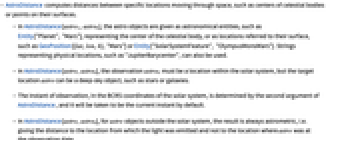AstroDistance[astro]
returns the physical distance to the astronomical object astro as currently observed from your geo location.
AstroDistance[astro,astro0]
returns the physical distance to the astronomical object astro as currently observed from astro0.
AstroDistance[astro,Dated[astro0,date]]
returns the physical distance to astro as observed from astro0 on the given date.


AstroDistance
AstroDistance[astro]
returns the physical distance to the astronomical object astro as currently observed from your geo location.
AstroDistance[astro,astro0]
returns the physical distance to the astronomical object astro as currently observed from astro0.
AstroDistance[astro,Dated[astro0,date]]
returns the physical distance to astro as observed from astro0 on the given date.
Details

- AstroDistance computes distances between specific locations moving through space, such as centers of celestial bodies or points on their surfaces.
- In AstroDistance[astro1,astro0], the astro objects are given as astronomical entities, such as Entity["Planet","Mars"], representing the center of the celestial body, or as locations referred to their surface, such as GeoPosition[{lat,lon,h},"Mars"] or Entity["SolarSystemFeature", "OlympusMonsMars"]. Strings representing physical locations, such as "JupiterBarycenter", can also be used.
- In AstroDistance[astro,astro0], the observation astro0 must be a location within the solar system, but the target location astro can be a deep-sky object, such as stars or galaxies.
- The instant of observation, in the BCRS coordinates of the solar system, is determined by the second argument of AstroDistance, and it will be taken to be the current instant by default.
- In AstroDistance[astro,astro0], for astro objects outside the solar system, the result is always astrometric, i.e. giving the distance to the location from which the light was emitted and not to the location where astro was at the observation date.
- In AstroDistance[astro,astro0], for astro objects in the solar system, the result is corrected for light time by default, but can be made geometric using AstroDistance[astro,{astro0,"LightTime""Geometric"}].
Examples
open all close allBasic Examples (3)
Scope (5)
Find the distance to the center of Jupiter as currently measured from the center of Mars:
This can also be expressed in these alternative forms:
Find the distance to the center of Jupiter from a point on the surface of Venus:
Compare with the distance between centers:
The difference is smaller than the radius of Venus, depending on the current geometric configuration:
Use geo entities for locations on the surface of the Earth or entities representing solar system features:
Compute the between the Sun and the solar system barycenter:
Compute the distance for the next 100 years, in units of gigameters, or millions of kilometers:
Compute distances to a list of astronomical objects:
The result is given in QuantityArray form:
Applications (4)
Construct a function that computes the geometric distance between the centers of Jupiter and Earth for a given Gregorian year:
Plot that distance between years 2020 and 2026:
Find the instant of closest approach in 2022:
Convert to the standard Gregorian calendar:
This is the distance between the Earth and the Sun for day d of year 2022:
Due to the eccentricity of Earth's orbit, the distance oscillates around 1 AU during a year:
The perihelion of a planet is defined as the moment of closest approach to the Sun:
In 2022 it happened on January 4, around 7am GMT:
The aphelion is defined as the moment of maximum distance to the Sun:
In 2022 it happened on July 4, also around 7am GMT:
Find the distance to the star Vega:
Compare to the distance observed from the Sun:
It oscillates around 1 AU as the Earth orbits around the Sun during a year:
The distance from the Sun also changes in time, due to proper motion of the star:
The distance is decreasing about 2.5 au per year, as reflected by the negative radial velocity of Vega:
Compare the relative size of the Sun as currently observed from the different planets:
Properties & Relations (3)
AstroDistance[astro,obsrvr] is equivalent to AstroPosition[astro,obsrvr]["Distance"]:
AstroDistance[astro1,astro2] takes into account the time that light takes to propagate from astro1 to astro2. Compute the distance at which Jupiter can be seen from Mars on this date:
This is the time that light takes to travel that distance:
This is the distance without taking into account that Jupiter moves during that time:
The difference is of the order of 10,000 miles:
This is the distance at which Mars can be seen from Jupiter at the same instant:
These results do not coincide:
However, the computation without light-time correction does coincide:
Use GeoPositionENU to compute the Euclidean distance to Principe Island from your location:
GeoDistance gives distances on the surface of the Earth, which are therefore longer:
Compare the Euclidean distance with the distance given by AstroDistance:
Deactivate all astrometric corrections to obtain full agreement:
Related Guides
History
Text
Wolfram Research (2022), AstroDistance, Wolfram Language function, https://reference.wolfram.com/language/ref/AstroDistance.html.
CMS
Wolfram Language. 2022. "AstroDistance." Wolfram Language & System Documentation Center. Wolfram Research. https://reference.wolfram.com/language/ref/AstroDistance.html.
APA
Wolfram Language. (2022). AstroDistance. Wolfram Language & System Documentation Center. Retrieved from https://reference.wolfram.com/language/ref/AstroDistance.html
BibTeX
@misc{reference.wolfram_2025_astrodistance, author="Wolfram Research", title="{AstroDistance}", year="2022", howpublished="\url{https://reference.wolfram.com/language/ref/AstroDistance.html}", note=[Accessed: 09-December-2025]}
BibLaTeX
@online{reference.wolfram_2025_astrodistance, organization={Wolfram Research}, title={AstroDistance}, year={2022}, url={https://reference.wolfram.com/language/ref/AstroDistance.html}, note=[Accessed: 09-December-2025]}